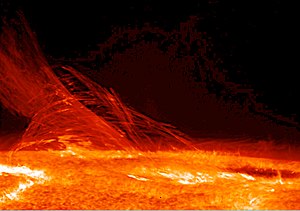Heat: Energy that is transferred from one body to another as the result of a difference in temperature
Heat, or thermal energy, is the sum of the kinetic energy of atoms or molecules.
In thermodynamics, heat means energy which is moved between two things when one of them has a higher temperature than the other.

Adding heat to something increases its temperature. Heat is not the same as temperature. The temperature of an object is the measure of the average speed of the moving particles in it. The energy of the particles is called the internal energy. When an object is heated, its internal energy can increase to make the object hotter. The first law of thermodynamics says that the increase in internal energy is equal to the heat added minus the work done on the surroundings.
Heat can also be defined as the amount of thermal energy in a system. Thermal energy is the type of energy that a thing has because of its temperature. In thermodynamics, thermal energy is the internal energy present in a system in a state of thermodynamic equilibrium because of its temperature. Heat is defined as a spontaneous flow of energy (energy in transit) from one object to another, caused by a difference in temperature between two objects. Objects do not possess heat.
Properties of Heat
Heat is a form of energy and not a physical substance. Heat has no mass.
Heat can move from one place to another in different ways:
The measure of how much heat is needed to cause a change in temperature for a material is the specific heat capacity of the material. If the particles in the material are hard to move, then more energy is needed to make them move quickly, so a lot of heat will cause a small change in temperature. A particle that is easier to move will need less heat for the same change in temperature.
Unless some work is done, heat moves only from hot things to cold things.
Measuring heat
Heat can be measured. That is, the amount of heat given out or taken in can be given a value. The calorie is one of the units of measurement for heat but the joule is also used for all kinds of energy including heat.
Heat is usually measured with a calorimeter. The energy in a material is allowed to flow into nearby water, which has a known specific heat capacity. The temperature of the water is then measured before and after, and heat can be found using a formula.
References
Related pages
Other websites
- Plasma heat at 2 gigakelvins - Article about extremely high temperature generated by scientists (Foxnews.com)
- Heat and Thermodynamics - Georgia State University
- Correlations for Convective Heat Transfer - ChE Online Resources
- An Introduction to the Quantitative Definition and Analysis of Heat written for High School Students Archived 2010-09-24 at the Wayback Machine

This article uses material from the Wikipedia Simple English article Heat, which is released under the Creative Commons Attribution-ShareAlike 3.0 license ("CC BY-SA 3.0"); additional terms may apply (view authors). Content is available under CC BY-SA 4.0 unless otherwise noted. Images, videos and audio are available under their respective licenses.
®Wikipedia is a registered trademark of the Wiki Foundation, Inc. Wiki Simple English (DUHOCTRUNGQUOC.VN) is an independent company and has no affiliation with Wiki Foundation.
